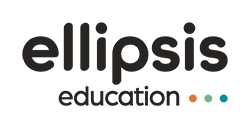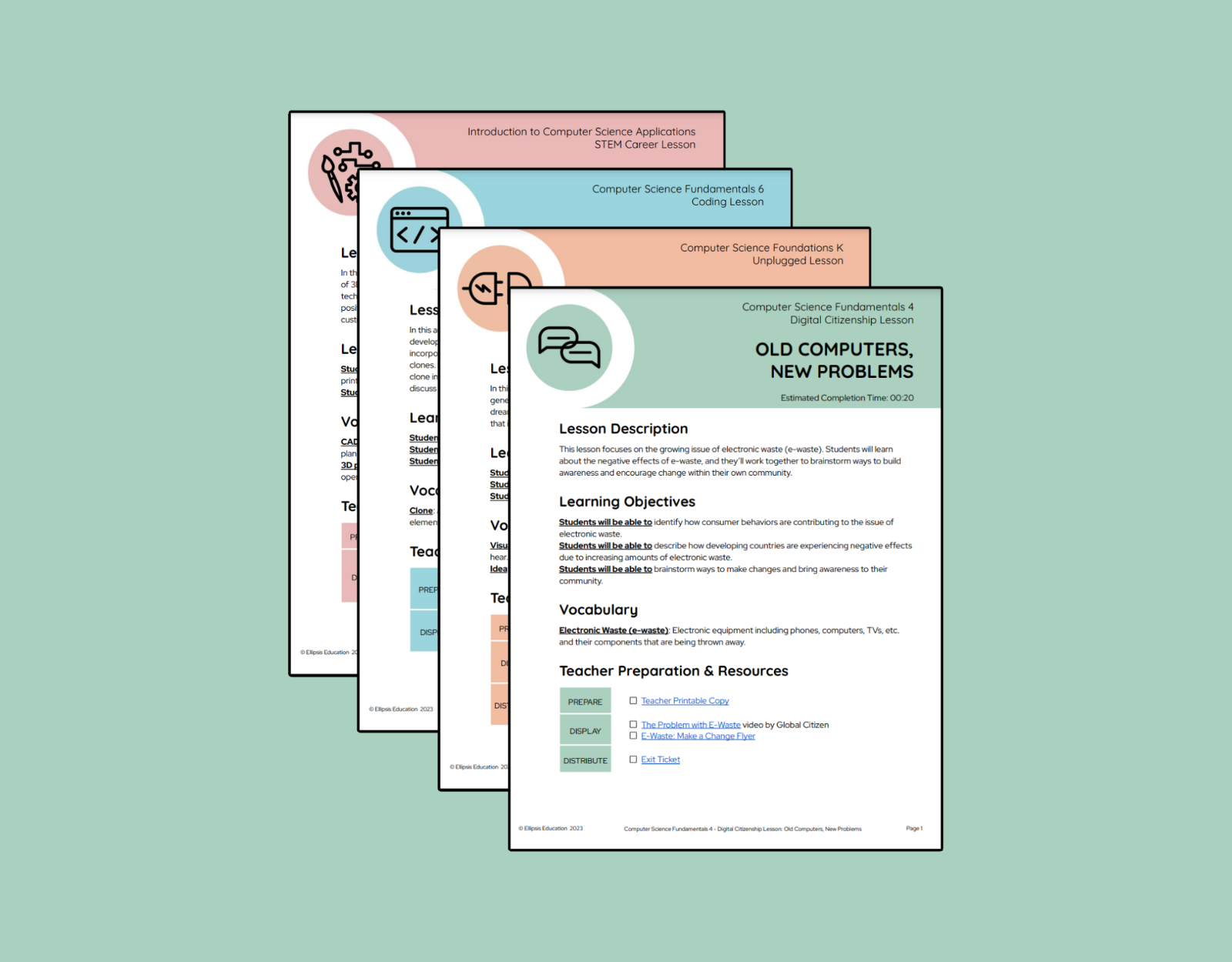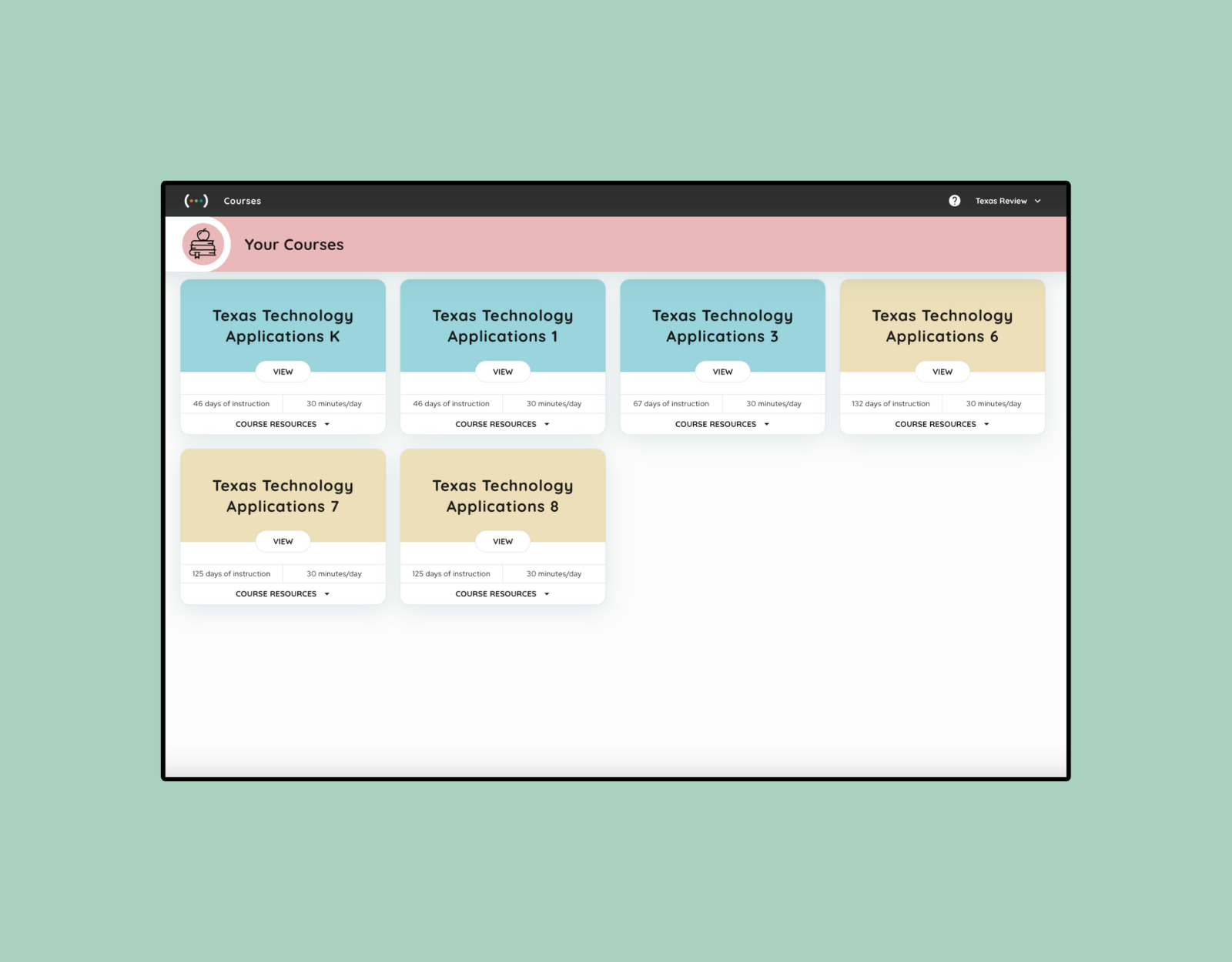Texas K-12 Computer Science Standards
Ellipsis Education by Coder Kids, Inc.
Bring computer science to life with Ellipsis’ Technology Applications Curriculum. Our K-5 curriculum is a state-adopted instructional material. Plus, explore our 6-8 TEKS-aligned computer science offering.
Why Ellipsis Education by Coder Kids, Inc.?
Computer science provides meaningful context for learning the new Technology Application TEKS.
Texas districts choose to work with Ellipsis Education because they share our beliefs:
Overview of Tech Apps TEKS Curriculum
Technology Applications Curriculum
Ellipsis is a full, grade-level differentiated curriculum that provides sequencing and context.
Plus, it’s aligned with the Tech Apps TEKS.
Texas Essential Knowledge and Skills for Technology Applications
Comprehensive curriculum from Ellipsis Education by Coder Kids, Inc. puts learning in context, so a teacher, not a machine, brings computer science to life. Explore curriculum for K-5 (state-adopted instructional material) and 6-8 (TEKS aligned).
Texas TEKS
Texas TEKS standards were passed in the 2012-2013 school year and are organized by grade level or grade band. The student standards can be found on the Texas Administrative Code website, and are organized into chapters indicating subject area, and subchapters indicating grade. Within the subcategories are specific TEKS standards. The TEKS grade-banded and grade-specific standards can be found at the links below:
-
High School: the high school standards vary by course. The standards are listed by course title underneath the “Rules” header.
Starting in the 2023-2024 school year, a new set of TEKS standards will be implemented in high school. Then, by 2024-2025, new K-8 TEKS standards will be implemented. View the new standards for each grade level at the links below:
-
Grades 9-12: the high school standards vary by course. The standards are listed by course underneath each course name.
Texas also has a set of standards for educators to use in all K-12 classrooms. These educator-specific standards are available on the Texas Texas Education Agency website. The fundamentals of computer science PDF is accessible here. These six standards act as a helpful TEKS guide, mapping out what is expected and required of teachers as they navigate teaching computer science. The first page of this PDF lists the standards, and the rest of the TEKS resource document specifies more information about each of the standards, including implementation expectations.
The Texas Education Agency (TEA) website hosts helpful resources for educators, including general TEA TEKS computer science information, computer science certification Texas, and a computer science practice test. As an additional resource for you, we offer free professional development webinars. Watch the webinars on demand and walk away with a free lesson and credit towards your Texas teacher certification.
Technology Applications Standards
The Technology Applications TEKS were developed in 2011 and revised in 2022. The updated Texas Technology Standards are slated for implementation in 2024.
The Technology Applications TEKS 2024 are divided into six “Knowledge and Skills” subject areas:
- Creativity and Innovation
- Communication and Collaboration
- Research and Information Fluency
- Critical Thinking, Problem Solving, and Decision Making
- Digital Citizenship
- Technology Operations and Concepts
Students are expected to gain mastery in these areas throughout the year, but the way the TEKS are implemented is up to the district. Some districts are having a dedicated Technology Applications class, while others are integrating Tech Apps learning with English, Math, or Science.
Compared to the 2011 Tech Apps TEKS, the revised standards have a much greater focus on coding skills. That’s why TEA TEKS Computer Science courses provide nice context for learning the Technology Applications Standards. In K-5, the only state-approved TEA TEKS Computer Science offering is from Ellipsis Education by Coder Kids, Inc. Explore our curriculum offering on our Texas Review landing page (Password: TexasReview1).
What Is Computer Science Education
The importance of computer science in education is clear as technology continues to advance. According to the Bureau of Labor Statistics, employment in computer and information technology occupations is projected to grow 11% from 2019 to 2029. Additionally, the TEA reports that Texas is expected to have the second-highest percentage of the nation’s future STEM job opportunities. Given this, shouldn’t we equip our students with these skills starting at a young age?
Currently, computer science standards span from K-12; computer science education begins with the Texas state standards kindergarten and goes all the way until AP Computer Science in high school. Most of these courses consist of a coding component, where students learn programming skills. The basic building blocks of coding such as loops, functions, and conditionals can be taught in elementary school and applied to more complex languages as students progress in their K-12 journey. As students attempt more advanced projects, such as developing websites, programs, and games, they are motivated to connect with their world and empowered to expand their skills.
Computer science education, however, is not only about coding. K 12 computer science also focuses on developing 21st century skills, such as the 4 C’s (communication, collaboration, computational thinking, and creativity). A strong foundation in these computer science skills will serve them well for years to come, regardless of the path they decide to pursue. The Texas computer science standards are designed to encourage multidisciplinary learning. For example, computer science standards can be integrated into other core subject areas, like the Texas science standards and Texas social studies standards.
K 12 Computer Science Curriculum
Ellipsis Education provides full-year K-12 computer science curriculum that aligns with the Texas computer science standards. The curriculum offers grade level differentiated learning pathways, aligns with all state and national computer science standards, and is continually updated to reflect changes in computer science. Ellipsis Education courses are customized to districts’ unique instructional strategy for computer science integration. This can mean incorporating computer science into an existing class period, adding to a specials rotation, or introducing a stand alone class. Courses are delivered with instructional resources teachers need to feel confident teaching computer science in K-12.
Our computer science curriculum for K-2 empowers you to engage your students with courses that fuel their interest. Coding lessons use ScratchJr, an introductory block coding language, perfect for emergent and early readers. In grades 3-5, inspire your students with courses that spark their creativity. Coding lessons use Scratch, a block based coding language, ideal for the transitional and fluent reader.
Our computer science curriculum middle school (6-8) helps you motivate your students with courses that connect to their world. Coding lessons use line based languages JavaScript, HTML, CSS, and Java to explore programming options.
Our computer science high school curriculum (9-12) helps you empower your students with courses that expand their skills. Coding lessons use JavaScript, Java, Python, and Godot to develop websites, programs, and games.
Explore our full k-12 computer science education course offering on our courses page. If any of these course options interest you, schedule a 30 minute call with one of our curriculum experts. Find the curriculum that will support every teacher as they inspire every student.
Computer Science Careers
After being introduced to computer science curriculum in K-12, students may be inspired to continue their computer science education. On a professional level, companies are recruiting for computer science degree jobs in cloud computing, app development, and statistical analysis. On an individual level, computational thinking, problem solving, and relationship building are all deeply influenced by computer science. This understanding of computer science jobs leads to much broader applications. you don’t necessarily need a degree in computer science; anyone that uses technology to solve problems can be considered a computer scientist!
Introducing computer science in the K-12 experience opens doors for students to pursue a computer science degree in college. The top computer science colleges in Texas, including Rice University, University of Texas-Austin, University of Texas-Dallas, and Texas A&M University offer concentrations in various areas of computer science, like computer information systems, information technology, computer software and applications, and computer systems networking. The reality is, though, students do not need to attend a university to pursue these computer science majors. Even non-STEM majors, like business, biology, and English use computer science skills to communicate ideas.
Likewise, computer science skills taught in K-12 can be applied directly to any career students pursue after high school. Computational thinking, problem solving, and teamwork can be applied in trades (like electrician, plumber, and HVAC) and other positions (like retail, restaurants, and reception).
Ellipsis Education spotlights the many forms of computer science careers in our My STEM Career series. In these interviews, hear from professionals, students, and teachers as they share how they built confidence in their computer science skills. Two particularly interesting interviews include Will Muto, a Product Technical Director at Industrial Light and Magic, who worked on Star Wars films, and Alia Enos, Software Developer II at 343 Industries, who works on the Halo video game series.
Ready to Learn More?
See how Technology Applications Curriculum from Ellipsis Education can work in your district. Request a meeting with our accounts team to share your goals and explore our Tech Apps curriculum. If interested, you can also explore our computer science offering for grades 6-8.






